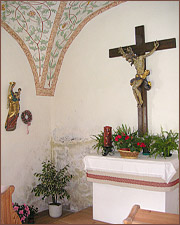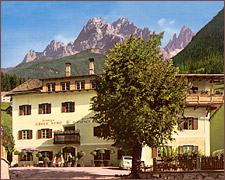HOTEL GOLDEN CROSS Kiniger Kunigunde VAT-No.: IT01548290210 CIN: IT021092A1VNYQ2Z8C Via San Vito 4 I-39030 Sesto (BZ) SOUTH TIROL - DOLOMITES Tel. +39 0474 710 247 Fax +39 0474 710 734 |
| WELCOME ROOMS RATES LEISURE TIME CONTACT ARRIVAL |
| History Of The House The Hotel »Golden Cross« is the oldest restaurant in Sesto and one of the first houses built in stone. It is already mentioned as a stone building in the oldest house record from the year 1629. Nobody knows anymore since when the inn has been run under this name. It used to be the Pauler Wirtstaverne. In the past, the word tavern used to be the common expression for a pub and the innkeeper was called "Gastgeb". One of the first innkeepers, perhaps the founder of the bar business, must have been called Paul. The inn was then named Pauler Wirtstaverne after him.
Next to the main house there is a chapel with the inscription 1582. It is said to be the oldest church in the valley. The position of the house in St. Veit naturally suggested itself as a tavern. The old country road from Innichen passed by and the St. Veitskirche (St. Veit's Church), built in 1384, was located nearby. The owners of the Pauler Wirtstaverne also attained the right to collect the toll for vehicles passing through. Only much later, after the main road no longer passed along the hill but rather along the bottom of the valley, was the toll place moved to the Kreuzberg. Several owners used to be Gastgeb (host), tollkeeper and also lawyers at the same time. As such they were the intermediaries between the people and the baronial guardians and judges in Heinfels. In the village they occupied a similar position as the mayor does today.
Apart from many fields and meadows a mill at the Sextnerbach (Sextner Brook), later called Mittermühle, belonged to the house. Until around 1800 its name was Pauler Mühle. Around 1920, the estate of the parents of Fritz of Pernwerth in Meran included an emerald ring about which legend says that a woman died in the Pauler Wirtstaverne and was buried there. After her funeral the valuable ring on her finger was remembered and the grave was opened in the night. The seemingly dead woman awoke and lived for another year but never laughed again.
In 1629 the house is mentioned as »Pauler Wirtstaverne« in a list of houses. The owner simultaneously was the tollkeeper and at the house was the tollgate for the road that led over the Kreuzberg. In the 17th century the owners were the family Anratter; Berenwerth became the owner through marriage. Heinrich of Berenwerth, 1683, was from Bozen K.K, tollkeeper/barrister. Jakob of Berenwert, 1657-1711, Gastgeb (host) and barrister in Sexten. Franz of Berenwerth to Bärenstein, 1691, barrister and tollkeeper, moves to Innichen and the estate is sold to Franz Schranzhofer, 1761, in 1734, tollkeeper and Gastgeb (host). In 1757 it is sold to Andrä Kopsguter of Innichen and in the same year to Georg Wassermann, 1686-1772, tollkeeper and Gastgeb (host) at the Kreuzberg. Then in 1803 it is sold to Josef Kofler, 1769-1839. Six generations of Kofler managed the house until Josef Kofler went missing in World War II near Belgrade in 1944. The business was continued by his daughter, Maria Kofler, married Kiniger. Since 1994 the house is led by daughter Kunigunde Kiniger, married Tschurtschenthaler. |
| Imprint | Privacy |
| © 2008 senso.bz |


